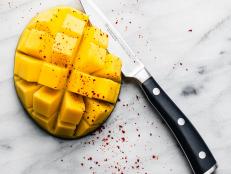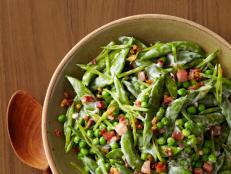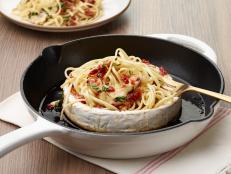3 of a Kind: Creative Kimchi Dishes That Switch Up the Base (Try Them at Home!)

3 of a Kind checks out three places across the country to try something cool, new and delicious.
Kimchi is having a moment: The traditional Korean dish is beloved for its fermented funkiness and the instant dose of umami it adds to any recipe. Though typically made with napa cabbage or daikon, kimchi is getting a creative overhaul in some restaurants. Lately, chefs have been experimenting with alternative kimchi bases — and finding undeniably pungent success.
Brussels Sprouts Kimchi at Blue Duck Tavern, Washington, D.C.
Everyone’s favorite brassica goes incognito at this upscale Georgetown restaurant, thanks to a clever preparation. Shaving the Brussels sprouts creates thin, ruffled shreds that soak up a heady bath of fish sauce, garlic, ginger, soy sauce and Korean chile flakes. After a week or two of fermentation, those transformed frills provide a tangy nest for rosemary seared scallops.
Ingredients:
2 pounds Brussels sprouts, shaved
1 1/2 tablespoons salt
1 tablespoon sugar
1 1/2 tablespoons garlic, minced
1 1/2 tablespoons ginger, minced
2 tablespoons fish sauce
1 teaspoon soy sauce
1 teaspoon cooked jasmine rice, at room temperature
1 cup scallions, roughly chopped
1 tablespoon Korean chile flakes (dried)
Directions:
Combine Brussels sprouts with salt and sugar in a bowl. Crush and smash the mixture until you see liquid seep out from the Brussels sprouts.
Puree garlic, ginger, fish sauce, soy sauce and rice. Add the pureed mixture, chopped scallions and chile flakes to the Brussels sprouts in the same bowl. Let the mixture sit at room temperature for 2 hours.
Pack the sprouts mixture tightly into an open-mouth container until you see liquid rise above the Brussels sprouts. Add a food-safe weight (i.e., a glass jar or small plate) to keep the Brussels sprouts submerged, then cover.
Leave at room temperature, in a dark and cool place, for 1 week minimum or up to 2 weeks maximum. This mixture can be saved in the refrigerator for up to 6 months.

Ramp Kimchi at Orchids at Palm Court, Cincinnati
Ramp season is officially in session, and like most chefs across the country, Orchids’ executive chef Todd Kelly makes the most of cult-favorite wild onions while he can. Deeper in flavor and aroma than leeks or scallions, ramps deliver a garlicky boost that tastes like spring at its greenest.
At Orchids, Kelly tosses these foraged gems with daikon and slathers them in a spicy paste of gochujang (fermented Korean chile paste), fermented shrimp and bourbon barrel-aged soy sauce for a slaw that’s perfect in fried rice or tacos.
Ingredients:
1 pound ramps, whites removed to the purple portion
1 tablespoon salt
1/3 cup sugar
3 red apples, cored and peeled
15 garlic cloves
3 ounces ginger
1/2 cup gochujang
2 tablespoons fish sauce
2 tablespoons fermented salted shrimp
1/4 cup bourbon barrel soy sauce
4 ounces daikon radishes
Directions:
Clean the ramps and cut into 5-inch sections. In a food processor, add salt, sugar, red apples, garlic, ginger, gochujang, fish sauce, shrimp and soy sauce, then puree into a paste.
Thinly julienne daikon in 5-inch sections and toss with the ramps. Wearing gloves, work the paste gently into the ramps and daikon.
Place the ramps in a glass jar and cover with cheesecloth. Store in a cool, dark place for 4 days. The fermentation process will begin. Remove the cheesecloth and replace with a tight-fitting lid. Refrigerate for 1 week.

Mustard Greens Kimchi at FuseBox, Oakland, Calif.
This tiny fusion restaurant turns out oversized Korean flavor profiles. Known for its housemade kimchis, FuseBox prepares a rainbow of fermented options as part of its daily banchan plate. On any given day you’ll find kimchis crafted from daikon, bok choy, Japanese cucumbers and breakfast radishes, but keep an eye out for the seasonal mustard greens. The sharp, peppery bite of the bitter greens lends extra liveliness to a kimchi paste rich with ginger, salted shrimp and crisp Korean pear.
Ingredients:
1 tablespoon sweet rice flour
1 tablespoon garlic paste (about 5 cloves crushed with a mortar and pestle)
1-inch-long piece fresh ginger, finely grated
2 scallions, cut into 1-inch strips
1 medium carrot, peeled and thinly sliced into 3-inch pieces
1/4 Korean Shingo pear, Asian pear or crisp apple, sliced into thin strips (optional)
3 tablespoons fine-ground gochugaru (Korean red chile powder)
3 tablespoons coarse-ground gochugaru (Korean red chile powder)
1 tablespoon seau jjot (small salted shrimp, found in refrigerated section of Korean grocery stores) or fish sauce
1/4 cup granulated sugar
8 ounces mustard greens, cut into bite-sized pieces
2 tablespoons coarse Korean sea salt
Directions:
In a small saucepan, add the rice flour and 1/2 cup ice-cold water. Place over medium-high heat and whisk until thickened, about 2 minutes. Remove from the heat and set aside to cool.
In a large bowl, combine the garlic, ginger, scallions, carrot, apple or pear, chile powders, salted shrimp and sugar. Add the rice powder-paste and mix together well till it becomes a soft paste. Cover and set aside.
Place mustard greens in large stainless steel bowl. Fill with cold water to cover mustard greens. Soak for 15 minutes.
Drain mustard greens in colander. Shake off excess water from mustard greens and clean the bowl. Return mustard greens to the bowl. Sprinkle with 2 tablespoons Korean sea salt, or to taste. Toss the salt with mustard greens by hand.
Set aside for 20 minutes. The mustard greens will wilt, as the salt will pull the water from the mustard greens. Toss the mustard greens again and set aside for another 20 minutes.
Pour off 90 percent of the salted mustard green water from the bowl. Gradually add and mix the kimchi paste with the mustard greens according to taste. Store in a tightly sealed container for 2 weeks in the refrigerator, or bury it in your backyard.
































